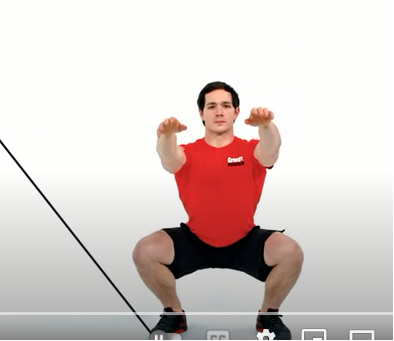An air squat is a basic exercise that involves no weights or equipment and primarily targets the lower body, specifically the glutes, hamstrings, and quadriceps muscles. It is also known as a bodyweight squat or a regular squat.
To perform an air squat, follow these steps:
- Begin by standing with your feet shoulder-width apart and toes pointed slightly outward.
- Keep your chest up and your back straight as you lower your hips down and back as if you are sitting in a chair.
- Lower yourself until your thighs are parallel to the ground or as low as you can go without compromising your form.
- Push through your heels to stand back up to the starting position.
Remember to keep your knees in line with your toes, and your weight on your heels as you perform the movement. You can also add variations to the air squat by performing them with a wider or narrower stance, adding a jump or pulse at the bottom, or incorporating weights for more resistance.
Air squats are a great exercise for building lower body strength, improving mobility, and increasing cardiovascular endurance. They can be performed anywhere and are suitable for individuals of all fitness levels.
Some tips to ensure proper form during air squats include:
- Keep your chest up and your back straight throughout the movement to maintain proper posture and prevent injury.
- Engage your core muscles to help stabilize your body as you lower and lift yourself.
- Keep your knees in line with your toes to prevent excessive stress on your knee joints.
- Lower yourself as far as you can without rounding your lower back or lifting your heels off the ground.
- Push through your heels to stand back up to the starting position.
You can incorporate air squats into your workout routine by performing them in sets of 10-15 reps, with 2-3 sets per session. As you get stronger, you can gradually increase the number of reps or sets or add weight to make the exercise more challenging.
Overall, air squats are a simple yet effective exercise that can help you build strength, endurance, and mobility in your lower body, and they require no equipment, making them a convenient choice for home workouts or when traveling.
Additionally, air squats can be modified to target different muscle groups or to add variation to your workout routine. Here are some examples of modified air squats:
- Sumo squat: Stand with your feet wider than shoulder-width apart and toes pointed outwards. Lower yourself down into a squat, keeping your knees in line with your toes. This variation targets your inner thighs and glutes more than a regular air squat.
- Jump squat: Perform a regular air squat, but add a jump at the top of the movement. This variation increases the intensity of the exercise and provides a cardiovascular challenge.
- Pistol squat: Stand on one leg and extend the other leg forward. Lower yourself down into a squat on one leg, keeping your raised leg extended in front of you. This variation requires more balance and stability and targets your quadriceps, glutes, and hamstrings.
Overall, air squats are a great exercise to incorporate into your workout routine, regardless of your fitness level or goals. They are a versatile and effective exercise that can help you build lower body strength, endurance, and mobility.
It’s worth noting that air squats can be used as a warm-up exercise to prepare your body for more intense exercises, such as weightlifting or plyometrics. Incorporating air squats into your warm-up routine can help increase your heart rate, improve your flexibility, and prepare your lower body muscles for more challenging exercises.
Moreover, air squats can be performed as a part of a circuit training workout, where you perform a series of exercises one after another with little to no rest in between. Circuit training is an excellent way to increase your cardiovascular endurance and burn more calories in a shorter amount of time.
In conclusion, air squats are a simple yet effective exercise that can be performed anywhere, anytime, without the need for equipment. They are a great way to build lower body strength, endurance, and mobility, and they can be modified to target different muscle groups and add variation to your workout routine. Whether you’re a beginner or an experienced athlete, air squats are a valuable addition to your fitness regimen.
Lastly, it’s essential to remember that proper form is critical when performing air squats to avoid injury and get the most out of the exercise. Some common mistakes to avoid include:
- Allowing your knees to collapse inward: This can put undue stress on your knee joints and increase your risk of injury.
- Rounding your lower back: This can strain your lower back muscles and lead to back pain.
- Lifting your heels off the ground: This can cause you to lose balance and place more stress on your knee joints.
- Leaning too far forward: This can put additional stress on your knees and lower back.
By keeping these tips in mind and practicing proper form, you can perform air squats safely and effectively. If you experience any pain or discomfort during the exercise, stop immediately and consult with a healthcare professional.
In conclusion, air squats are a great exercise for building lower body strength, endurance, and mobility. They can be performed anywhere, anytime, without equipment, and can be modified to target different muscle groups and add variety to your workout routine. With proper form and consistent practice, air squats can help you achieve your fitness goals and improve your overall health and well-being.
![]()
